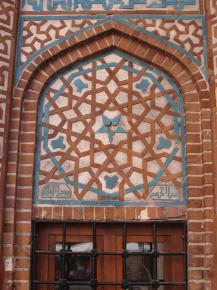Period Band: A
Curatorial Rating: 1
From Brick into Stone: Islamic Architecture in Anatolia during the Long Thirteenth Century
Tutor: Richard McClary
Description
This course will immerse students in the medieval urban fabric of central and eastern Anatolia and involves the close study of the monuments erected in and around the major cities, with a focus on Konya, Sivas, Kayseri and Erzurum. During the period from 1170 to 1300 a wide range of competing identities, including Christian and Muslim as well as Turkic and Persian, resulted in the emergence of a new, hybrid architectural aesthetic. This drew on antecedent developments to the east, in Iran, Central Asia and Anatolia, as well as across the Caucasus, from Aleppo and Damascus to the south and the Byzantines to the west.
The role of iconography and the reasons for increased levels of patronage, as well as the function of buildings and specifics of construction will be examined, alongside an investigation of the consequences of Islamisation and the beginning of Ilkhanid Mongol rule.
The role of female patronage is examined, alongside that of the male elites. In addition, the interaction and exchange with the Christian architecture of the Armenian and Georgian population will give students an understanding of the wider context and allow them to address issues concerning frontier, periphery and centre in the medieval world.
This transnational and interdisciplinary course will give students an awareness of the extent of trade and cultural exchange in western Asia and the eastern Mediterranean between Muslim and Christian populations in the medieval period.
Objectives
By the end of the module, students should have acquired:
- an understanding of the cultural and historical context of Anatolia in the thirteenth century.
- the skills to study and analyse monuments in forensic detail in order to understanding the working methods of the craftsmen responsible for their construction.
- comprehension of the shift from the construction of brick monuments towards a greater use of stone, and to understand the major innovations in the architectural use of glazed ceramics.
- the ability to determine the disparate sources upon which craftsmen drew in the creation of a new aesthetic.
- an understanding of the projection of power and authority through architectural patronage.
- knowledge of the wide range of sources drawn upon in the creation of a distinctive regional style in the medieval period.
- the skills to critically assess readings and present a clear and coherent argument based on the results of their research.
Preliminary Reading
- Akurgal, E. K. 1980. The Art and Architecture of Turkey, New York, NY
- Arık, R. and Arık, O. 2014. Tiles: Treasures of Anatolian Soil: Tiles of the Seljuk and Beylik Periods, İstanbul
- Blessing, P.2014. Rebuilding Anatolia after the Mongol Conquest: Islamic Architecture in the Lands of Rūm, 1240–1330, Farnham
- Blessing, P. and Goshgarian, R. 2017. Architecture and Landscape in Medieval Anatolia, 1100-1500, Edinburgh
- Cahen, C. 2001. The formation of Turkey: the Seljukid Sultanate of Rum: eleventh to fourteenth century, New York, NY
- Eastmond, A. 2004. Art and Identity in Thirteenth Century Byzantium: Hagia Sophia and the Empire of Trebizond, Aldershot
- Flood, F. B. 2009. Objects of Translation: Material Culture and Medieval “Hindu-Muslim” Encounter, Princeton, NJ / Oxford
- Hillenbrand, R. (ed.) 1994. The Art of the Saljūqs in Iran and Anatolia – Proceedings of a Symposium held in Edinburgh in 1982, Costa Mesa, CA
- Lange, C. and Mecit, S. (eds.) 2011. The Seljuqs; Politics, Society and Culture, Edinburgh
- McClary, R. 2017. Rum Seljuq Architecture, 1170-1220. The Patronage of Sultans, Edinburgh
- Mecit, S. 2014. The Rum Seljuqs: Evolution of a Dynasty, London
- Mepisashvili, R. and Tsintsadze, V. 1979. The Arts of Ancient Georgia, London
- Önge, M. 2007. “Caravanserais as Symbols of Power in Seljuk Anatolia”, in Osmond, J. and Cimdiņa, A. (eds.) Power and culture: identity, ideology, representation, Pisa, pp. 49-69
- Pancaroǧlu, O. 2004. “The Itinerant Dragon-Slayer: Forging Paths of Image and Identity in Medieval Anatolia”, Gesta, Vol. 43, No. 2, pp. 151-164
- Peacock, A. C. S. and Yıldız, S. N. (eds.) 2013. The Seljuks of Anatolia, Court and Society in the Medieval Middle East, London
- Redford, S. 1991. “The Alaeddin Mosque in Konya Reconsidered”, Artibus Asiae, Vol. 51, pp. 54-74
- ---- 1993. “The Seljuks of Rum and the Antique”, Muqarnas X, pp. 148-156
- ---- 1993. “13th century Rum Seljuq Palaces and Palace imagery”, Pre-Modern Islamic Palaces, Ars Orientalis, Vol. 23, pp. 219-239
- Walker, A. 2011. “Middle Byzantine aesthetics of power and the incomparability of Islamic Art: The architectural ekphraseis of Nikolaos Mesarites”, Muqarnas XXVII, pp. 79-101
- Watson, W. (ed.) 1975. The Art of Iran and Anatolia from the 11th to the 13th century AD, Percival David Foundation of Chinese Art Colloquium on Art and Archaeology in Asia 4 (25-28 June 1973) London
- Yalman, S. 2012. “ʿAla al-Din Kayqubad Illuminated: A Rum Seljuq Sultan as Cosmic Ruler”, Muqarnas XXIX, pp. 151-186

Module code HOA00067I
